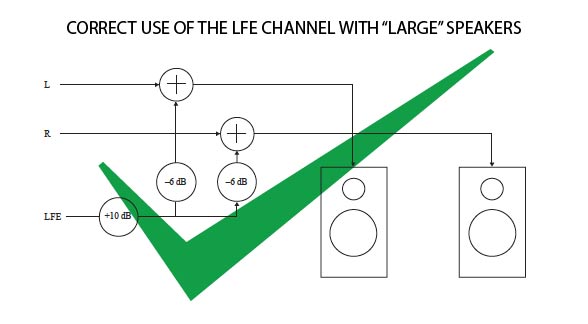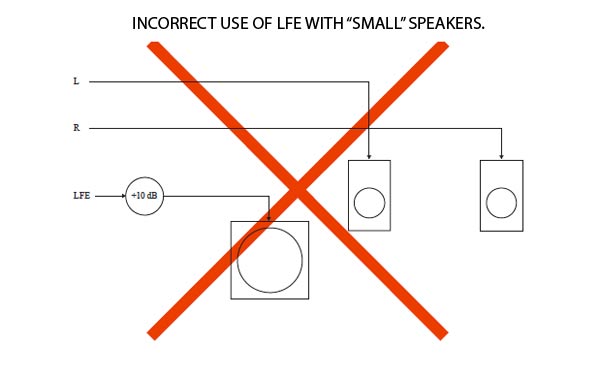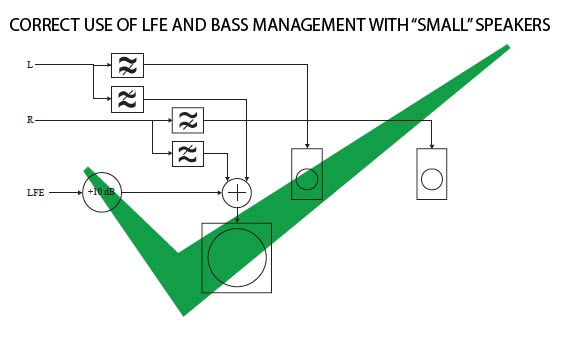Making the LFE Channel Go Boom
Getting extremely loud, low frequencies are the meat and potatoes of movie soundtracks. Movie directors and sound supervisors want to deliver the sonic impact of explosions, volcanoes, and earthquakes while you’re sitting in a dark room with a bunch of other aural thrill seekers. The need to reproduce low frequency sounds that impact an audience requires a sound system that can deliver very high signal levels at low frequencies.
It’s not so difficult to do at a commercial movie theater but it does present a real challenge at home. The specification of the Dolby Digital (AC-3) compression scheme used to power the soundtracks of DVD-Video discs goes down to 0 Hz. The signal level needed to drive extreme levels is likely to cause digital clipping. We’ve already talked about how a 10 dB gain is provided to the LFE channel in the analog domain to achieve the desired amplitude levels for the bombs, car crashes, and firepower of the US Navy. The diagram below shows the LFE signal can be combined with the main left and right signals and sent to the main loudspeakers.
Figure 1 – Two main channels and the LFE channel added to the main speakers (from the ITU document).
If the main loudspeakers are equipped to handle the energy required for the low end, the LFE channel with the 10 dB of additional gain provided in the analog domain by the AVR can be added to them. The diagram shows two main channels but the same principal applies to a monophonic setup. In that case the 6 dB attenuation would not be required because there are half as many channels. In reality, adding the LFE channel to all of the loudspeakers of a multichannel setup would require more than 6 dB attenuation.
How should the LFE channel be connected to the subwoofer speaker? The diagram below (also from the ITU-R BS. 775-3 document) shows the wrong way to make that connection. The problem in this arrangement is that the main speakers are small and unable to handle the low frequencies delivered by the left and right channels. The subwoofer is only getting the “low frequency effects or enhancements” that would drive the small mains into distortion. The frequencies at the very low end would be reproduced but the low end of the main program would not.
Figure 2 – Bass frequencies being sent to the small main loudspeakers.
The right way to get the entire range of frequencies required by the program is to use bass management, which we’ve seen is a method that extracts frequencies lower than 120 Hz and adds them to the LFE channel to be reproduced by the subwoofer speaker. Take a look at the diagram below. It shows how properly filtered left and right main signals can be combined with the LFE (with the analog boost of 10 dB) to ensure the full program is reproduced.
FIGURE 3 – A properly configure 2.1 reproduction system with bass management.
The LFE channel and subwoofer are not the same thing. The LFE channel is the “enhancement” of the low-end and the subwoofer is the loudspeaker that delivers is AND/OR a bass managed combination of the low-end.





Mark,
It seems to me that in doing your music mixes, there would be two valid approaches:
You could create a .1 track with monaural low bass information, attenuated by 10db, to be automatically boosted back up on playback, or
You could simply omit the .1 track and mix all the channels full range, and rely upon the listener to either use full range speakers or bass management that sends the low bass from any smaller speakers to the subwoofer(s).
I think that the second approach would be the best for surround music mixed naturally, though I could see the judicious use of the .1 channel for the cannons in the 1812 Overture and similar sound effects.
Phil, you’re suggestions are appreciated but there are challenges with both. Remember that the boosting of the LFE channel is used only on Dolby Digital .1 LFE channels and not on the LFE outputs of SACD and DVD-Audio discs. If the manufacturers of AVR handled music discs correctly, then there would no need to modify my LFE output. When I mix my projects, I don’t use bass management. That means the the main 5 speakers get all of the program material. I dial up the “boom” output to the LFE channel but I DO NOT raise the “non boom” knob (which would remove the low end signals from the mains). The result is that the mixes are enhanced by the addition of a subwoofer but they work just fine without. If you solo (isolate) the output of the subwoofer you will notice that the sound is band limited to about 70 Hz (not the usual 120 Hz in typical bass management). The effect is subtle but does make a difference in the overall sound.
The omission of the LFE channel is problematic as well. I have received phone calls and emails from customers asking if I use the LFE channel. There was a set of the Beethoven Symphonies that didn’t use the LFE and customers with sub felt cheated. I think my approach is a good compromise. I’d be interested in how many customers have experienced excessive low-end levels. I’ve certainly not heard about any problems.
Mark,
Are you even still creating new DVD-Audio disks?
While the Oppo Blu-ray players can play DVD-A and SACD disks, the 10 db boost of the LFE channel on playback applies not only to “DVD style” Dolby Digital and DTS, it also applies to Dolby TrueHD and DTS HD Master Audio, which I assume are what you use on your Blu-rays.
I’ve not bought your mixes on disk but as downloaded FLAC versions of your PCM 5.1 stage perspective mixes. Since no Dolby or DTS processing takes place on playback of these files, and thus presumably no boost of the LFE channel, I’ve not had any problem with the LFE being too hot. I play back all my multichannel material networked off my LAN through an Oppo BDP-93, running its multichannel analog output into my pre-HDMI Yamaha RX-v457.
I have Steely Dan’s Gaucho in multiple versions, including the multichannel mix in both SACD and DVD-A copies. While the 96/24 5.1 DVD-A copy sounds glorious, the 5.1 SACD sounds muddy, since its LFE channel was, per the SACD spec, not cut back by 10db. (The SACD’s CD-compatibility track sounds fine.) My past reading has suggested that SACD was “odd man out” with respect to not using the 10 db cut. My DVD-As appear to have uniformly had the 10 db cut built in.
I’ve read in user support forums that some AVRs have a control buried in their menus to enable and disable the 10 db boost (though mine does not). I assume that such controls are limited to the LFE channel.
However, general speaker trim controls – whether in the AVR or on the back of the sub itself, are not only an annoyance to adjust on a per-disk basis but would cut back the managed bass from the smaller speakers along with the LFE.
Phil
Guess I’m a little slow but I’ve read all the installments on bass management and still can’t wrap my mind around the need for the +10 db boost of the LFE channel? Why isn’t it flat with the rest of the speaker array? Why don’t they just boost it on the mastering end if everyone needs it? I’m confused on this issue.
Because of the potential for digital clipping. If the mixes have a -10 dB level, the system can accommodate the very loud EFX and then be brought up to full level in the analog outputs of the receiver.
Hello
The REL company’s long-established, well-reviewed UK range of ‘SubWoofers’ has two inputs that are controlled separately. One for the 5.1 for movies and the other directly from the stereo POWER outputs of an amplifier. http://rel.net/rel-story/technology/
This way, the work with both stereo music to augment the bottom end of speakers and the Effects channel in movies.
Regards
Stuart
Thanks, it’s refreshing to see a company taking the time to understand the issue AND include a solution in their products.
Hey Mark
I just want to also bring to your attention another product, check out the most musical sub I have ever heard. http://www.rythmikaudio.com/amplifiers.html. Especially the Amp model A370-xlr3. it also has dual inputs that allow for separate .1 and low Hz inputs. In my system I set the sub crossover at 40Hz in the AVR and then crossover the left and right channels with a highpass at 200hz (or there about) and send it to the other side of the amps, two subs. I am not aware of two many instruments that go below 40hz other than maybe a pipe organ
I’ve struggled with bass management connection issues playing back DVD-A & SACD discs and now FLAC & DSF 5.1 files. The solution I came up with is a passive summing box that I built out of a pro DI box. It takes the left, right, and LFE channels and sums them to mono (with 1,000 ohm resistors) then balances the mono signal with the DI transformer. The balanced line from the box runs 30 feet to a remote digital crossover and power amps for the six subs. The box works very well and I wonder why no one has built something like it for the home theater market.
Very clever, Russ. And thanks for the detailed description. I’m wondering about the “power amps for the six subs” part of your comment. Do you really run six subwoofers or are these the low end drivers of your main speakers?
Yes, I run six subs. I’ll keep the description brief. The subs are grouped at different places around the room in a semi-“swarm” configuration. Each group of subs use different crossover, eq and delay settings and are powered by pro digital amps.
Thanks Russ.
Hello! I wonder if somebody could help me. I’m having problems with lfe reproduction on my Denon X-1200W receiver and Yamaha NS-SW200 subwoofer. When Audyssey is on (AUTO mode), watching DD 5.1 content the subwoofer reproduces flobbing sound even at 40% volume. On Direct mode reproduction of low volumes is better, but the ‘flobbing” sound is again noticeable at high volume… I’m wondering what is causing this. The subwoofer is brand new… I would really appreciate any kind of help…